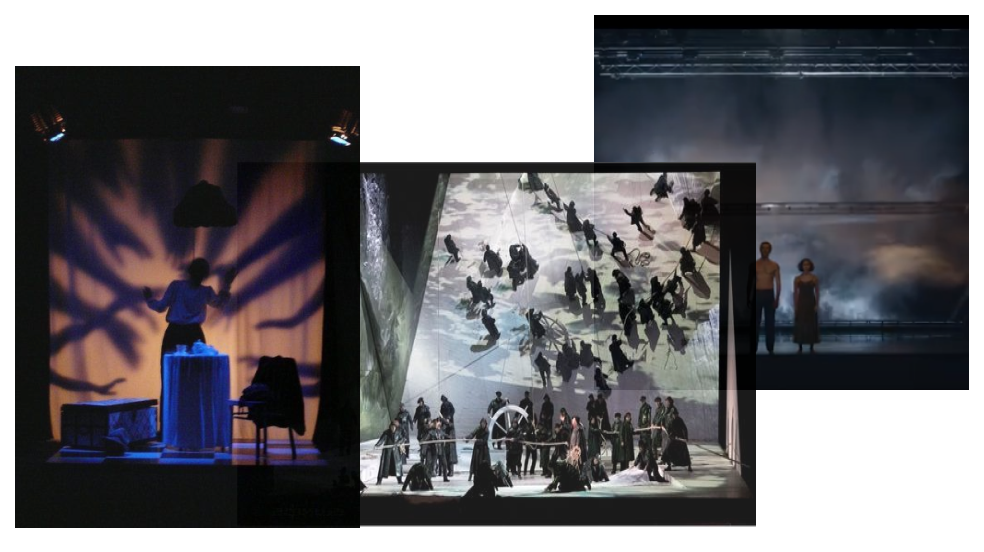
Azura
Jan.2024 - Apr.2024
Timeline —
Role —
Stage Designer Interaction Designer
Rhino Blender Adobe Set Figma
Collaborator —
Individual Project
Tools —

Azura is a conceptual stage design for the "Believe" scene in Finding Neverland, crafted by distilling the scene's key themes and emotions into a reimagined form. The front stage, representing reality, features rotating mechanisms that symbolize both the transition of the scene and the emotional journey of the main character. Layered backdrops depict the world of imagination, shifting in harmony with the front stage. Enhanced by immersive projections and innovative lighting, Azura invites you to explore a boundless realm of wonder, discovery, and emotional depth.
“A transformative and interactive stage design project inspired by Finding Neverland musical, where reality seamlessly merges with imagination.”

01. Introduction of Finding Neverland
This interactive stage design project is inspired by the musical Finding Neverland, which explores the creation of J.M. Barrie's Peter Pan.
The narrative follows Barrie, a struggling playwright who finds inspiration through his friendship with the Llewelyn Davies family. As Barrie forms a close bond with the children, he discovers a world of imagination and wonder, ultimately crafting a timeless tale.
01. Background
Act 1 Scene 4 - “Believe”
The 'Believe' scene invites the audience to embrace the magic of imagination. During this time, Barrie is facing a low point in his playwriting career, while the Llewelyn kids is grieving the loss of their father.
In this moment, Barrie inspires belief in the impossible, transforming the garden into a lagoon on the sea.
My FN Performance Photo in High School
Building upon the narrative’s emotional core, the “Believe” scene emerges as a natural focal point for this project.
02. Why Believe?
Beginning - "Believe" scene marks the start of the story
Essence - This moment encapsulates the essence of the musical, which is the power of imagination
Engagement - It deeply engages the audience, drawing them into the narrative's enchanting world
The 'Believes' stage offers a wealth of opportunities for exploration. As an iconic stage, it features intriguing transformations and unique characteristics.
To fully appreciate the meaning behind the “Believe” scene and its imaginative potential, it's important to understand the creative roots of Finding Neverland.
The musical is based on the 2004 movie of the same name, which in turn was inspired by the play The Man Who Was Peter Pan by Allan Knee, a bibliography of JM Barrie.
The musical uses primarily traditional technology to create the stage and experience, such as lighting and sound design. These technologies provide a relatively immersive environment, but there is no way for the audience to become directly involved.
03. Creation History
Understanding the characters in the “Believe” scene helps reveal the emotional depth and narrative tension that drive this pivotal moment, building on the historical context and thematic foundation.
In this scene, there are two main groups: Peter / Mr. Barrie with the Llewelyn family. A significant conflict unfolds between these groups, highlighting the contrast between 'following the heart and imagination' and 'facing reality and submitting to life.'
04. Character

02. Stage Redesign
01. Ideation
With a deeper understanding of the story, characters, and emotional significance of the “Believe” scene, the next step was to reimagine how the stage itself could better support and elevate this moment. The design process began by exploring symbolic forms and new technologies that could enhance immersion and reflect the narrative’s themes.
Architectural Inspiration - Circular Shape
Continuity & Wholeness: A circle has no beginning or end, symbolizing the limitless nature of imagination and belief
Focus & Attention: Encourage everyone to focus on the power of imagination and creativity
Projection Design
By attempting to add new projection technologies, the stage can enrich the narrative with visual metaphors and immerse the audience in the play
02. Sketches
Following the ideation phase, initial sketches were developed to visually translate abstract concepts.
Front Stage: Real world with garden elements.
Center Stage: Combination, rotating stage represents eternal transition.
Background: Imagination world with fairytale and waving elements.
02. Exploded Axon
After mapping out the conceptual structure and visual language of the stage in initial sketches, I moved on to detailing the design with greater precision. This exploded axonometric view breaks down the spatial composition.
Once the design was fully defined through technical drawings, I moved on to the physical modeling phase to bring the concept to life in three dimensions. This step was crucial for testing spatial relationships, material layering, and the stage's overall emotional atmosphere.
Some model making process:
04. Physical Model
Final model photos
03. Technical Drawing
To further refine the conceptual design into a buildable structure, I translated the exploded axon into a set of detailed architectural drawings.
Detailed Plan
Detailed Elevation
Detailed Section

03. Interactive Stage
After finishing the physical model, I started thinking about how the stage could evolve from a static form into a responsive, immersive environment. This led me to explore digital tools that could simulate the dynamic interaction between actors, the stage, and the audience.
I use sketches to visualize projections that transform the central stage into a glowing lagoon, reflecting the lyrics and emotional tone of the scene. By extending the oceanic ambiance beyond the stage and into the audience area, I blur the line between performance and reality.
01. Storyboard
I continued refining the stage experience through digital modeling and rendering, building on the storyboard.
I tested how lighting conditions, projection surfaces, and environmental effects, such as water reflections, could work together to transform the static stage into a dynamic narrative space using Rhino for modeling and Blender for rendering.
02. Working Process
After a series of iterations—from concept sketches and physical models to digital renderings—the final scene brings the entire vision to life. This scene visualizes the emotional climax of Finding Neverland and represents the potential of stage design to transcend its physical boundaries, inviting belief, wonder, and shared imagination.
Immerse yourself in the world of fantasy.
03. Final Scene

04. Final Reflection
This stage design project was an incredibly fun and enriching experience. It challenged me to think beyond aesthetics and engage with storytelling, emotion, and interaction in multidimensional ways. I especially enjoyed exploring different materials and modes of expression. I found the iterative process to be both rewarding and inspiring.
If I had more time, I would further explore how the stage could respond in real time to the actors’ movements or musical cues, enhancing the sense of interaction. I would also refine the physical model to make it more detailed and delicate in its craftsmanship.
01. Takeaways + Possibilities




















